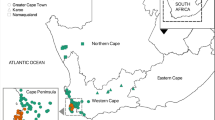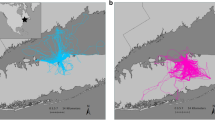Abstract
With increasing urbanization, some animals are adapting to human-dominated systems, offering unique opportunities to study individual adaptation to novel environments. One hypothesis for why some wildlife succeed in urban areas is that they are subsidized with anthropogenic food. Here, we combine individual-level movement patterns with diet composition based on stable isotope analysis to assess the degree to which a rapidly growing population of coyotes (Canis latrans) in Chicago consumes anthropogenic resources. We used telemetry to classify coyotes into three groups based on social class and home range composition: (1) residents with home ranges in urban nature preserves; (2) residents with home ranges that had a high proportion of urban land; and (3) transients that had relatively large home ranges and variable use of urban land. We found that natural and anthropogenic resources in this system can be reliably partitioned with carbon isotopes. Mixing models revealed that resident coyotes associated with most urban nature preserves consumed trace to minimal amounts of anthropogenic resources, while coyotes that live in the urban matrix consume moderate (30–50 %) to high (>50 %) proportions of anthropogenic resources. Lastly, we found evidence of prey switching between natural and anthropogenic resources and a high degree of inter-individual variation in diet among coyotes. In contrast to the expectation that urban adaptation may dampen ecological variation, our results suggest individuality in movement and diet exemplifies the successful establishment of coyotes in urban Chicago. Our study also suggests that direct anthropogenic food subsidization is not a prerequisite for successful adaptation to urban environments.




Similar content being viewed by others
References
Araújo MS, Bolnick DI, Layman CA (2011) The ecological causes of individual specialization. Ecol Lett 14:948–958
Atwood TC, Weeks HP, Gehring TM (2004) Spatial ecology of coyotes along a suburban-to-rural gradient. J Wildl Manag 68:1000–1009
Bolnick DI, Svanbäck R, Fordyce JA, Yang LH, Davis JM, Hulsey CD et al (2003) The ecology of individuals: incidence and implications of individual specialisation. Am Nat 161:1–28
Bolnick DI, Ingram T, Stutz WE, Snowberg L, Lau OL, Paull J (2010) Ecological release from interspecific competition leads to decoupled changes in population and individual niche width. Proc R Soc Lond B 277:1789–1797
Calenge C (2006) The package adehabitat for the R software: a tool for the analysis of space and habitat use by animals. Ecol Model 197:516–519
Caut S, Angulo E, Courchamp F (2009) Variation in discrimination factors (Δ15N and Δ13C): the effect of isotopic diet values and applications for diet reconstruction. J Appl Ecol 46:443–453
Cavillini P (1996) Variation in the social system of the red fox. Ethol Ecol Evol 8:323–342
Contesse P, Hegglin D, Gloor S, Bontadina F, Deplazes P (2004) The diet of urban foxes (Vulpes vulpes) and the availability of anthropogenic food in the city of Zurich, Switzerland. Mamm Biol 69:81–95
Crooks KR, Soulé ME (1999) Mesopredator release and avifaunal extinctions in a fragmented system. Nature 400:563–566
Doncaster CP, Dickman CR, MacDonald DW (1990) Feeding ecology of red foxes (Vulpes vulpes) in the city of Oxford, England. J Mammal 71:188–194
Farquhar GD, Ehleringer JR, Hubick KT (1989) Carbon isotope discrimination and photosynthesis. Annu Rev Plant Physiol 40:503–537
Fedriani JM, Kohn MH (2001) Genotyping faeces links individuals to their diet. Ecol Lett 4:477–483
Fedriani JM, Fuller TK, Sauvajot RM (2001) Does availability of anthropogenic food enhance densities of omnivorous mammals? An example with coyotes in southern California. Ecography 24:325–331
Fischer JD, Cleeton SH, Lyons TP, Miller JR (2012) Urbanization and the predation paradox: the role of trophic dynamics in structuring vertebrate communities. Bioscience 62:809–818
Gehrt SD (2004) Ecology and management of striped skunks, raccoons, and coyotes in urban landcscapes. In: Fascione N, Delach A, Smith M (eds) People and predators: from conflict to conservation. Island Press, Washington, DC
Gehrt SD (2007) Ecology of coyotes in urban landscapes. Wildlife Damage Management Conferences, Proceedings: Paper 63
Gehrt SD, Riley SPD (2010) Coyotes (Canis latrans). In: Gehrt SD, Riley SPD, Cypher BL (eds) Urban carnivores: ecology, conflict, and conservation. The Johns Hopkins University Press, Baltimore, p 79
Gehrt SD, Anchor C, White LA (2009) Home range and landscape use of coyotes in a major metropolitan landscape: conflict or coexistence? J Mammal 90:1045–1057
Gehrt SD, Brown JL, Anchor C (2011) Is the urban coyote a misanthropic synanthrope? The case from Chicago. Cities and the Environment (CATE) 4(1). http://digitalcommons.lmu.edu/cate/vol4/iss1/3. Accessed Apr 2014
Gese EM, Rongstad OJ, Mytton WR (1988) Home range and habitat use of coyotes in southeastern Colorado. J Wildl Manag 52:640–646
Gittleman JL, Harvey PH (1982) Carnivore home-range size, metabolic needs, and ecology. Behav Ecol Sociobiol 10:57–63
Goszczynski J (2002) Home ranges in red fox: territoriality diminishes with increasing area. Acta Theriol 47:103–114
Grimm NB, Faeth SH, Golubiewski NE, Redman CL, Wu J, Bai W, Briggs JM (2008) Global change and the ecology of cities. Science 319:756–760
Hadidian J, Prange S, Rosatte R, Riley SPD, Gehrt SD (2010) Raccoons (Procyon lotor). In: Gehrt SD, Riley SPD, Cypher BL (eds) Urban carnivores: ecology, conflict, and conservation. The Johns Hopkins University Press, Baltimore, pp 35–47
Hare PE, Fogel ML, Stafford TW, Mitchell AD, Hoering TC (1991) The isotopic composition of carbon and nitrogen in individual amino acids isolated from modern and fossil proteins. J Archaeol Sci 18:277–292
Harris S (1981) An estimation of the number of foxes (Vulpes vulpes) in the city of Bristol, and some possible factors affecting their distribution. J Appl Ecol 18:455–465
Heiss RS, Clark AB, McGowan KJ (2009) Growth and nutritional state of American crow nestlings vary between urban and rural habitats. Ecol Appl 19:829–839
Hirons AC, Schell DM, St. Aubin DJ (2001) Growth rates of vibrissae of harbor seals (Phoca vitulina) and Steller sea lions (Eumetopias jubatus). Can J Zool 79:1053–1061
Hobson KA, Schell DM, Renouf D, Noseworthy E (1996) Stable carbon and nitrogen isotopic fractionation between diet and tissues of captive seals: implications for dietary reconstructions involving marine mammals. Can J Fish Aquat Sci 53:528–533
Howell RG (1982) The urban coyote problem in Los Angeles County. In: Marsh RE (ed) Proceedings of the tenth vertebrate pest conference. University of California, Davis, pp 21–23
Howland MR, Corr LT, Young SMM, Jones V, Jim S, Van Der Merwe NJ, Mitchell AD, Evershed RP (2003) Expression of the dietary isotope signal in the compound-specific δ13C values of pig bone lipids and amino acids. Int J Osteoarchaeol 13:54–65
Jahren AH, Kraft RA (2008) Carbon and nitrogen stable isotopes in fast food: signatures of corn and confinement. Proc Natl Acad Sci USA 105:17855–17860
Laliberte AS, Ripple WJ (2004) Range contractions of North American carnivores and ungulates. Bioscience 54:123–138
Lavin SR, Van Deelen TR, Brown PW, Warner RE, Ambrose SH (2003) Prey use by red foxes (Vulpes vulpes) in urban and rural areas of Illinois. Can J Zool 81:1070–1082
McKinney ML (2002) Urbanization, biodiversity, and conservation. Bioscience 52:883–890
Miller C, Campbell ALK, Yeagle JA(2001) Attitudes of homeowners in the greater Chicago Metropolitan Region toward nuisance wildlife. Human dimensions program report SR-00-02. Illinois Natural History Survey, Champaign
Moller AP (2008) Flight distance of urban birds, predation, and selection for urban life. Behav Ecol Socio 63:63–75
Morey PS, Gese EM, Gehrt SD (2007) Spatial and temporal variation in the diet of coyotes in the Chicago metropolitan area. Am Mid Nat 158:147–161
Nelson JL, Cypher BL, Bjurlin CD, Creel S (2007) Effects of habitat on competition between kit foxes and coyotes. J Wildl Manag 71:1467–1475
Newsome SD, Tinker MT, Monson DH, Oftedal OT, Ralls K, Staedler MM et al (2009) Using stable isotopes to investigate individual diet specialization in California sea otters (Enhydra lutris nereis). Ecology 90:961–974
Newsome SD, Ralls K, Van Horn Job C, Fogel ML (2010) Stable isotopes evaluate exploitation of anthropogenic foods by the endangered San Joaquin kit fox (Vulpes macrotis mutica). J Mammal 91:1313–1321
Newsome SD, Fogel ML, Kelly L, Martinez del Rio C (2011) Contributions of direct incorporation from diet and microbial amino acids to protein synthesis in Nile tilapias (Oreochromis niloticus). Funct Ecol 25:1051–1062
Newsome SD, Tinker MT, Gill VA, Hoyt ZN, Doroff A, Nichol L, Bodkin JL (2015) The interaction of intraspecific competition and habitat on individual diet specialization: a near range-wide examination of sea otters. Oecologia. doi:10.1007/s00442-015-3223-8
Parnell AC, Inger R, Bearhop S, Jackson AL (2010) Source partitioning using stable isotopes: coping with too much variation. PLoS ONE 5:e9672
Partecke J, Gwinner E (2007) Increased sedentariness in European Blackbirds following urbanization: a consequence of local adaptation? Ecology 88:882–890
Partecke J, Schwabl I, Gwinner E (2006) Stress and the city: urbanization and its effects on the stress physiology in European blackbirds. Ecology 87:1945–1952
Phillips DL, Newsome SD, Gregg JW (2005) Combining sources in stable isotope mixing models: alternative methods. Oecologia 144:520–527
Prange S, Gehrt SD, Wiggers EP (2003) Demographic factors contributing to high raccoon densities in urban landscapes. J Wildl Manag 67:324–333
R Core Team (2014) R: a language and environment for statistical computing. R Foundation for Statistical Computing, Vienna. http://www.R-project.org. Accessed Apr 2014
Riley SPD, Sauvajot RM, Fuller TK, York EC, Kamradt DE, Bromley C, Wayne RK (2003) Effects of urbanization and habitat fragmentation on bobcats and coyotes in southern California. Conserv Biol 17:566–576
Robertson A, McDonald RA, Delahay RJ, Kelly SD, Bearhop S (2013) Whisker growth in wild Eurasianbadgers Meles meles: implications for stable isotope and bait marking studies. Eur J Wildl Res 59(3):341–350
Roth JD, Hobson KA (2000) Stable carbon and nitrogen isotopic fractionation between diet and tissue of captive red fox: implications for dietary reconstruction. Can J Zool 78:848–852
Scales J, Hyman J, Hughes M (2011) Behavioral syndromes break down in urban song sparrow populations. Ethology 117:887–895
Shochat E, Warren PS, Faeth SH, McIntyre NE, Hope D (2006) From patterns to emerging processes in urban evolutionary ecology. Trends Ecol Evol 21:186–191
Sih A, Ferrari MCO, Harris DJ (2011) Evolution and behavioural responses to human-induced rapid environmental change. Evol Appl 4:367–387
Sih A, Cote J, Evans M, Fogarty S, Pruitt J (2012) Ecological implications of behavioral syndromes. Ecol Lett 15:278–289
Sikes RS, Gannon WL, Carroll DS, Danielson BJ, Dragoo JW et al (2011) Guidelines of the American Society of Mammalogists for the use of wild mammals in research. J Mammal 92:235–253
Svanbäck R, Bolnick DI (2007) Intraspecific competition drives increased resource use diversity within a natural population. Proc R Soc Lond B 274:839–844
Svanbäck R, Persson L (2004) Individual diet specialisation, niche width and population dynamics: implications for trophic polymorphisms. J Anim Ecol 73:973–982
Teeri JA, Stowe LG (1976) Climatic patterns and the distribution of C4 grasses in North America. Oecologia 23:1–12
Tinker MT, Bentall G, Estes JA (2008) Food limitation leads to behavioral diversification and dietary specialization in sea otters. Proc Natl Acad Sci USA 105:560–565
Tyrrell L, Newsome SD, Fogel ML, Viens M, Bowden R, Murray MJ (2013) Vibrissae growth rates and trophic discrimination factors in captive southern sea otters (Enhydra lutris nereis). J Mammal 94(2):331–338
Vanderklift MA, Ponsard S (2003) Sources of variation in consumer-diet δ15N enrichment: a meta-analysis. Oecologia 136:169–182
Wang Y, Moskovits DK (2001) Tracking fragmentation of natural communities and changes in land cover: applications of Landsat data for conservation in an urban landscape (Chicago Wilderness). Conserv Biol 15:835–843
White LA, Gehrt SD (2009) Coyote attacks on humans in the United States and Canada. Hum Dimens Wildl 14:419–432
Acknowledgments
We thank Luke Tyrrell, Kelli Blomberg, Ryan Jones, and Deborah Boro for laboratory assistance and Anne Jakle for constructive reviews. Funding was provided by the Forest Preserve District of Cook County, Cook County Animal and Rabies Control, and the Max McGraw Wildlife Foundation. We especially thank Chris Anchor and Donna Alexander for their support, and the many technicians involved in field and laboratory work.
Author information
Authors and Affiliations
Corresponding author
Additional information
Communicated by Craig A. Layman.
Rights and permissions
About this article
Cite this article
Newsome, S.D., Garbe, H.M., Wilson, E.C. et al. Individual variation in anthropogenic resource use in an urban carnivore. Oecologia 178, 115–128 (2015). https://doi.org/10.1007/s00442-014-3205-2
Received:
Accepted:
Published:
Issue Date:
DOI: https://doi.org/10.1007/s00442-014-3205-2




